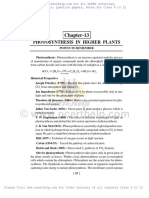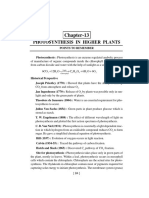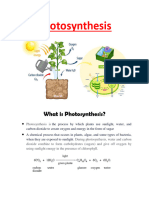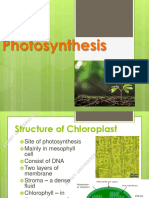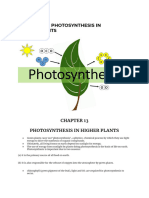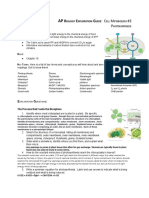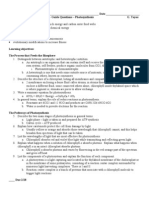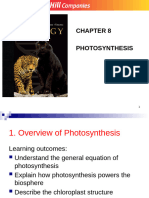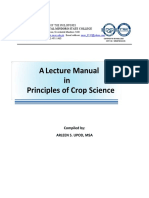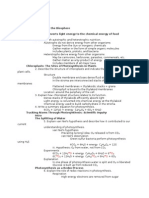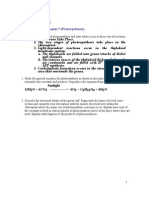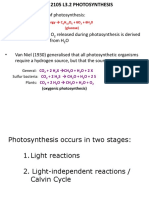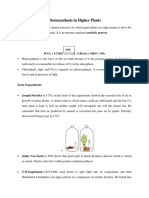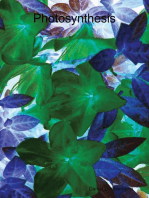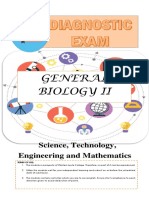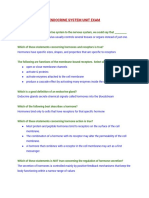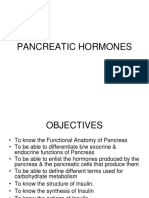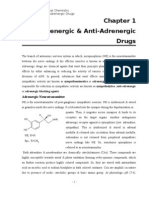Chapter 13 - Photosynthesis in Higher Plants PDF
Chapter 13 - Photosynthesis in Higher Plants PDF
Uploaded by
AdityaCopyright:
Available Formats
Chapter 13 - Photosynthesis in Higher Plants PDF
Chapter 13 - Photosynthesis in Higher Plants PDF
Uploaded by
AdityaOriginal Title
Copyright
Available Formats
Share this document
Did you find this document useful?
Is this content inappropriate?
Copyright:
Available Formats
Chapter 13 - Photosynthesis in Higher Plants PDF
Chapter 13 - Photosynthesis in Higher Plants PDF
Uploaded by
AdityaCopyright:
Available Formats
Visit www.ncerthelp.
com For All NCERT solutions,
CBSE sample papers, Question papers, Notes for Class 6 to 12
Chapter-13
PHOTOSYNTHESIS IN HIGHER PLANTS
POINTS TO REMEMBER
Photosynthesis : Photosynthesis is an enzyme regulated anabolic process
of manufacture of organic compounds inside the chlorophyll containing cells
from carbon dioxide and water with the help of sunlight as a source of energy.
6CO2 + 12H 2 O
Light
→ C6 H12 O6 + 6H 2 O + 6O 2
Chlorophyll
Historical Perspective
Joseph Priestley (1770) : Showed that plants have the ability to take up
CO2 from atmosphere and release O2.
Jan Ingenhousz (1779) : Release of O2 by plants was possible only in sun-
light and only by the green parts of plants.
Theodore de Saussure (1804) : Water is an essential requirement for pho-
tosynthesis to occur.
Julius Von Sachs (1854) : Green parts in plant produce glucose which is
stored as starch.
T. W. Engelmann (1888) : The effect of different wavelength of light on
photosynthesis and plotted the first action spectrum of photosynthesis.
C. B. Van Niel (1931) : Photosynthesis is essentially a light dependent reac-
tion in which hydrogen from an oxidisable compound reduces CO2 to form
sugar. He gave a simplified chemical equation of photosynthesis.
Hill (1937) : Evolution of oxygen occurs in light reaction.
Calvin (1954-55) : Traced the pathway of carbon fixation.
Hatch and Slack (1965) : Discovered C4 pathway of CO2 fixation.
Site for photosynthesis : Photosynthesis takes place only in green parts of
the plant, mostly in leaves. Within a leaf, photosynthesis occurs in mesophyll
cells which contain the chloroplasts. Chloroplasts are the actual sites for photo-
synthesis. The thylakoids in chloroplast contain most of pigments required for
capturing solar energy to initiate photosynthesis. The membrane system (grana)
[ 84 ]
Please Visit www.ncerthelp.com For Video lectures of all subjects Class 9 to 12
Visit www.ncerthelp.com For All NCERT solutions,
CBSE sample papers, Question papers, Notes for Class 6 to 12
is responsible for trapping the light energy and for the synthesis of ATP and
NADPH. Biosynthetic phase (dark reaction) is carried in stroma.
Pigments involved in photosynthesis :
Chlorophyll a : (Bright or blue green in chromatograph). Major pigment,
act as reaction centre, involved in trapping and converting light into
chemical energy.
Chlorophyll b : (Yellow green)
Xanthophyll : (Yellow)
Carotenoids : (Yellow to yellow-orange)
In the blue and red regions of spectrum shows higher rate of photosynthesis.
Light Harvesting Complexes (LHC) : The light harvesting complexes are
made up of hundreds of pigment molecules bound to protein within the
photosystem I (PSI) and photosystem II (PSII). Each photosystem has all the
pigments except one molecule of chlorophyll ‘a’ forming a light harvesting sys-
tem (antennae). The reaction centre (chlorophyll a) is different in both the pho-
tosystems.
Photosystem I (PSI) : Chlorophyll ‘a’ has an absorption peak at 700 nm
(P700).
Photosystem II (PSII) : Chlorophyll ‘a’ has absorption peak at 680 nm
(P680).
Process of photosynthesis : It includes two phases - Photochemical phase
and biosynthetic phase.
(i) Photochemical phase (Light reaction) : This phase includes - light
absorption, splitting of water, oxygen release and formation of ATP and
NADPH.
(ii) Biosynthetic phase (Dark reaction) : It is light independent phase,
synthesis of food material (sugars).
Photophosphorylation : The process of formation of high-energy
chemicals (ATP and NADPH).
Cyclic photophosphorylation : Two photosystems work in series − First
PSII and then PSI. These two photosystems are connected through an electron
transport chain (Z. Scheme). Both ATP and NADPH + H+ are synthesised by this
process. PSI and PSII are found in lamellae of grana, hence this process is
carried here.
[ 85 ]
Please Visit www.ncerthelp.com For Video lectures of all subjects Class 9 to 12
Visit www.ncerthelp.com For All NCERT solutions,
CBSE sample papers, Question papers, Notes for Class 6 to 12
Non-cyclic photophosphorylation : Only PSI works, the electron
circulates within the photosystem. It happens in the stroma lamellae (possible
location) because in this region PSII and NADP rectase enzyme are absent. Hence
only ATP molecules are synthesised.
The electron transport (Z-Scheme) : In PS II, reaction centre (chlo. a)
absorbs 680 nm wavelength of red light which make the electrons to become
excited. These electrons are taken up by the electron acceptor that passes them
to an electron transport system (ETS) consisting of cytochromes. The
movement of electron is down hill. Then, the electron pass to PSI and move
down hill further.
The splitting of water : It is linked to PS II. Water splits into H+, O and
electrons.
2H2O → 4H+ + O2 + 4e−
Chemiosmotic Hypothesis : Chemiosmotic hypothesis explain the
mechanism of ATP synthesis in chloroplast. In photosynthesis, ATP synthesis is
linked to development of a proton gradient across a membrane. The electrons
are accumulated inside of membrane of thylakoids (in lumen). ATPase has a
channel that allows diffusion of protons back across the membrane. This
releases energy to activate ATPase enzyme that catalyses the formation of ATP.
Biosynthetic phase in C3 plants :
ATP and NADH, the products of light reaction are used in synthesis of
food. The first CO2 fixation product in C3 plant is 3-phosphoglyceric acid or
PGA. The CO2 acceptor molecule is RuBP (ribulose bisphosphate). The cyclic
path of sugar formation is called Calvin cycle on the name of Melvin Calvin, the
discoverer of this pathway. Calvin cycle proceeds in three stages :
(1) Carboxylation : CO2 combines with ribulose 1, 5 bisphosphate to
form 3 PGA in the presence of RuBisCo enzyme.
(2) Reduction : Carbohydrate is formed at the expense of ATP and
NADPH.
(3) Regeneration : The CO2 acceptor ribulose 1, 5-bisphosphate is formed
again .
6 turns of Calvin cycles and 18 ATP molecules are required to synthesize
one molecule of glucose.
[ 86 ]
Please Visit www.ncerthelp.com For Video lectures of all subjects Class 9 to 12
Visit www.ncerthelp.com For All NCERT solutions,
CBSE sample papers, Question papers, Notes for Class 6 to 12
The C4 pathway : C4 plants have special type of leaf anatomy, they tolerate
higher temperatures. In this pathway, oxaloacetic acid (OAA) is the first stable
product formed. It is 4 carbon atoms compound, hence called C4 pathway (Hatch
and Slack Cycle). The leaf has two types of cells : mesophyll cells and Bundle
sheath cells (Kranz anatomy). Initially CO2 is taken up by phosphoenol pyruvate
(PEP) in mesophyll cells and changed to oxaloacetic acid (OAA) in the presence
of PEP carboxylase. Oxaloacetate is reduced to maltate/asparate that reach into
bundle sheath cells.
The oxidation of maltate/asparate occurs with the release of O2 and
formation of pyruvate (3C). In high CO2 concentration RuBisCo functions as
carboxylase and not as oxygenase, the photosynthetic losses are prevented. RuBP
operates now under Calvin cycle and pyruvate transported back to mesophyll
cells and changed into phosphoenol pyruvate to keep the cycle continue.
Photosrespiration : The light induced respiration in green plants is called
photorespiration. In C3 plants some O2 binds with RuBisCo and hence CO2
fixation is decreased. In this process RuBP instead of being converted to 2
molecules of PGA binds with O 2 to form one molecule of PGA and
phosphoglycolate.
Law of Limiting Factors : If a chemical process is affected by more than
one factor, then its rate will be determined by the factor which is nearest to its
minimal value. It is the factor which directly affects the process if its quantity is
changed.
Factors affecting photosynthesis :
1. Light
2. Carbondioxide
3. Temperature
4. Water
QUESTIONS
Very Short Answer Questions (1 mark each)
1. Name two photosynthetic pigments belonging to Caretenoids.
2. How many molecules of ATP are required for synthesis of one molecule of
glucose in C3 and C4 pathways ?
3. What part of sunlight is most suitable for photosynthesis ?
4. Which one of the photosystems can carry on photophosphorylation
independently ?
[ 87 ]
Please Visit www.ncerthelp.com For Video lectures of all subjects Class 9 to 12
Visit www.ncerthelp.com For All NCERT solutions,
CBSE sample papers, Question papers, Notes for Class 6 to 12
5. Name two plants that can carry out photosynthesis at night.
6. Under what conditions the affinity of RuBP carboxylase for carbon dioxide
and for oxygen increase ?
7. Name the scientist who proposed the C4 pathway.
8. Where does carbon fixation occur in chloroplast ?
9. Which compound acts as CO2 acceptor in Calvin cycle ?
10. Name the end products of light reaction.
Short Answer Questions-II (2 marks each)
11. Why does the rate of photosynthesis decline in the presence of continuous
light ?
12. Why do green plants start evolving carbon dioxide instead of oxygen on a
hot sunny day ?
13. Fill in the space, left blank in the given table to bring the difference between
C3 and C4 plants :
S. No. Characterisitcs C3 plants C4 plants
1. Cell type One type (mesophyll) ......(a)......
2. CO2 acceptor .......(b)...... Phosphoenol
pyruvate (PEP)
3. First CO2 fixation 3-PGA ........(c)........
product
4. Optimum temperature ......(d)....... 30º C to 45º C
14. State two functions of accesory pigments found in thylakoids.
15. Why do C4 plants are more expensive than C3 plants ?
Short Answer Questions-I (3 marks each)
16. The figure shows the effect of light on the rate of photosynthesis. Based on
the graph, answer the following questions :
(i) At which point(s) A, B or C in the curve, light is a limiting factor ?
(ii) What could be the limiting factor(s) in region A ?
[ 88 ]
Please Visit www.ncerthelp.com For Video lectures of all subjects Class 9 to 12
Visit www.ncerthelp.com For All NCERT solutions,
CBSE sample papers, Question papers, Notes for Class 6 to 12
(iii) What do region C and D represent on the curve ?
Rate of photo synthesis
B C
E
D
L ig h t In te n sity
17. When and why does photorespiration take place in plants ? How does this
process result in a loss to the plant ?
18. What are the steps that are common to C3 and C4 photosynthesis ?
19. Two potted plants were kept in an oxygen free environment in transparent
containers, one in total darkness and the other in sunlight. Which one of the
two is likely to survive more ? Justify your answer by giving the reason.
20. (a) In the diagram shown below label A, B and C. What type of phospho-
rylation is possible in this ?
P h otosystem I
A
P
AT
Pi
P+
AD
L igh t
B
C
(b) Give any two points of difference between cyclic and non-cyclic
photophosphorylation.
Long Answer Questions (5 marks each)
21. Describe C4 pathway in a paddy plant. How is this pathway an adaptive
advantage to the plant ?
22. Explain the process of biosynthetic plase of photosynthesis occuring in
chloroplast.
[ 89 ]
Please Visit www.ncerthelp.com For Video lectures of all subjects Class 9 to 12
Visit www.ncerthelp.com For All NCERT solutions,
CBSE sample papers, Question papers, Notes for Class 6 to 12
23. (a) Give steps of ATP synthesis in chloroplasts through chemiosmosis.
(b) Schematically represent non-cyclic photophosphoryaltion in plants.
ANSWERS
Very Short Answers (1 mark)
1. Carotene and Xanthophyll.
2. In C3 pathway = 18 ATP molecules
In C4 pathway = 30 ATP molecules
3. Blue and red regions of the light spectrum are the most effective in
photosynthesis.
4. PS-I.
5. Opuntia, Chenopodium, Bougainvillea.
6. In temperature and oxygen concentration.
7. Hatch and Slack.
8. Carbon fixation takes place in stroma.
9. Ribulose 1, 5 bisphosphate.
10. ATP, NADPH2 and O2.
Short Answers-II (2 marks)
11. Increase in incident light beyond a point causes the breakdown of
chlorophyll.
12. On a hot sunny day, enzyme RuBP carboxylase becomes active and its
affinity for CO2 decreases and for O2 increases. Consequently more and more
photosynthetically fixed carbon is lost by photorespiration.
13. (a) Two types cells : mesophyll and bundle sheath.
(b) RuBP
(c) OOA (oxaloacetic acid)
(d) 20ºC-25ºC
14. (a) Absorption of light and transfer of energy to chlorophyll ‘a’.
(b) Protect chlorophyll ‘a’ from photo oxidation.
[ 90 ]
Please Visit www.ncerthelp.com For Video lectures of all subjects Class 9 to 12
Visit www.ncerthelp.com For All NCERT solutions,
CBSE sample papers, Question papers, Notes for Class 6 to 12
15. Because they require more energy (30 ATPs) in synthesizing one glucose
molecule as compared to C3 - 18ATPs.
Short Answers-I (3 marks)
16. (i) ‘B’
(ii) CO2 and temperature
(iii) ‘C’ represents to constant rate of photosynthesis, ‘D’ is the light
saturation intensity at which rate of photosynthesis is maximum.
17. Refer Page no. 220, NCERT, Text Book Biology for class XI.
18. Hints :
(a) Photolysis of H2O and photophosphorylation occurs in both C3 and C4
plants.
(b) In both, dark reaction occurs in stroma.
(c) Calvin cycle results in the formation of starch in both the plants.
(d) During dark reaction both types of plants undergo the phases of
carboxylation and regeneration.
19. Hints :
• The plant in sunlight will survive for longer period.
• Light is essential for photosynthesis.
20. (a) (A) e− acceptor
(B) Electron transport system
(C) Chlorophyll P700
(b) Refer Page no. 212, NCERT Text Book of Biology for Class XI.
Long Answers (5 marks)
21. Refer Page no. 218, NCERT Text Book of Biology for Class XI.
22. Refer Page no. 216, NCERT Text Book of Biology for Class XI.
Hint : Three stages of Calvin cycle : Carboxylation, reduction and regen-
eration.
23. (a) Refer Page no. 213 (Chemiosmotic Hypothesis), NCERT Text Book
of Biology for Class XI.
(b) Refer Fig. 13.5 (Z-Scheme of light reaction), NCERT Text Book of
Biology for Class XI.
[ 91 ]
Please Visit www.ncerthelp.com For Video lectures of all subjects Class 9 to 12
You might also like
- Biology: a QuickStudy Laminated Reference GuideFrom EverandBiology: a QuickStudy Laminated Reference GuideRating: 3 out of 5 stars3/5 (2)
- General Biology I - Quarter 2 - Module 1a - Week 2Document22 pagesGeneral Biology I - Quarter 2 - Module 1a - Week 2Richard Bachar100% (11)
- Chapter 13 - Photosynthesis in Higher Plants PDFDocument8 pagesChapter 13 - Photosynthesis in Higher Plants PDFAdityaNo ratings yet
- Enzyme AssaysDocument3 pagesEnzyme AssaysAudreySlitNo ratings yet
- Photosynthesis in Higher PlantsDocument17 pagesPhotosynthesis in Higher Plantsyahake5036No ratings yet
- Chapter-13: Photosynthesis in Higher PlantsDocument8 pagesChapter-13: Photosynthesis in Higher PlantssujushNo ratings yet
- Photosynthesis in Higher PlantsDocument8 pagesPhotosynthesis in Higher PlantsAditya VenkatNo ratings yet
- 11 Biology Notes ch13 Photosymthesis in Higher PlantsDocument6 pages11 Biology Notes ch13 Photosymthesis in Higher PlantsManan AhujaNo ratings yet
- 11 Biology Notes Ch13 Photosymthesis in Higher PlantsDocument6 pages11 Biology Notes Ch13 Photosymthesis in Higher PlantsAAYUSH KUMARNo ratings yet
- Photosynthesis in Higher Plant NotesDocument14 pagesPhotosynthesis in Higher Plant Notesbasumatijal13No ratings yet
- Photosynthesis in Higher PlantsDocument6 pagesPhotosynthesis in Higher PlantskhushiNo ratings yet
- Chapter 13 Photosynthesis in Higher PlantsDocument7 pagesChapter 13 Photosynthesis in Higher Plantsakhilkaushik.1327No ratings yet
- Class-Xi Biology Study Material 2022-23Document21 pagesClass-Xi Biology Study Material 2022-23devil luciferNo ratings yet
- Unit 4 Photosynthesis-1Document7 pagesUnit 4 Photosynthesis-1Abraham BanjoNo ratings yet
- Function of PhotosynthesisDocument58 pagesFunction of PhotosynthesisJulian ChristopherNo ratings yet
- Chapter-4 Photosynthesis in Higher Plants: Very Short Answers QuestionsDocument10 pagesChapter-4 Photosynthesis in Higher Plants: Very Short Answers QuestionsPraveen KumarNo ratings yet
- Photosynthesis in Higher PlantsDocument49 pagesPhotosynthesis in Higher PlantsRiya NarangNo ratings yet
- Photosynthesis in Higher Plants - by @MadXAbhiOfficialDocument11 pagesPhotosynthesis in Higher Plants - by @MadXAbhiOfficialmintukumar696969No ratings yet
- PhotosynthesisDocument21 pagesPhotosynthesissujoysarkargurgaonNo ratings yet
- CHP 5 PhotosynthesisDocument43 pagesCHP 5 PhotosynthesisSIMBA The Lion KingNo ratings yet
- Photosynthesis 123Document4 pagesPhotosynthesis 123Alyssa L.J. Dela Cruz (Aly)No ratings yet
- Photosynthesis in Higher Plants: Mind MapDocument79 pagesPhotosynthesis in Higher Plants: Mind MapMiryaNo ratings yet
- Chapter-4 PhotosynthesisDocument4 pagesChapter-4 Photosynthesiskavitaruby1980No ratings yet
- Photosynthesis Respiration Report FinalDocument53 pagesPhotosynthesis Respiration Report FinalIvan Jhon AnamNo ratings yet
- Ch-13 - Photosynthesis in Higher PlantsDocument11 pagesCh-13 - Photosynthesis in Higher PlantsSam RNo ratings yet
- AP Biology Exploration Guide - Cell Metabolism #3Document6 pagesAP Biology Exploration Guide - Cell Metabolism #3Gunnar OlsonNo ratings yet
- 13 Photosynthesis in Higher PlantsDocument9 pages13 Photosynthesis in Higher PlantsAarushi GoyalNo ratings yet
- 16782Document2 pages16782Hardana Gading Perdana PutraNo ratings yet
- Photosynthesis in Higher Plants: Class: 11 Sub: Biology Chapter - 13Document7 pagesPhotosynthesis in Higher Plants: Class: 11 Sub: Biology Chapter - 13kuldeep kumarNo ratings yet
- APBioCh10ReadingGuide10 11Document2 pagesAPBioCh10ReadingGuide10 11Sergio LivingroomsNo ratings yet
- CHMEICAL BONDING PART 2.pdf - 20240911 - 192300 - 0000Document11 pagesCHMEICAL BONDING PART 2.pdf - 20240911 - 192300 - 0000dbishnushankarNo ratings yet
- AP Bio Unit 2 Study GuideDocument2 pagesAP Bio Unit 2 Study GuideRana MehaiNo ratings yet
- MRFM Q63 H SMR 5 WZRVCJ RKDocument5 pagesMRFM Q63 H SMR 5 WZRVCJ RKBalbeer KaurNo ratings yet
- BIOENERGETICSDocument3 pagesBIOENERGETICSFaryal akramNo ratings yet
- Ch05 Answerkey Hoefnagels EssDocument7 pagesCh05 Answerkey Hoefnagels EssCry The WolffNo ratings yet
- Lecture 4 Carbohydrate-GlycolysisDocument20 pagesLecture 4 Carbohydrate-GlycolysisBiology BảoNo ratings yet
- chapter 8Document26 pageschapter 8mouza saifNo ratings yet
- Photosynthesis in Higher Plants - Shobhit NirwanDocument21 pagesPhotosynthesis in Higher Plants - Shobhit NirwanVraj M Barot100% (3)
- Hotosynthesis: Big PictureDocument3 pagesHotosynthesis: Big Picturehomamunfat100% (1)
- CS01-Chapter 2Document48 pagesCS01-Chapter 2AJ MoralesNo ratings yet
- AP Biology Chapter 10 Notes - PhotosynthesisDocument5 pagesAP Biology Chapter 10 Notes - PhotosynthesisAustinNo ratings yet
- Photosynthesis Study GuideDocument3 pagesPhotosynthesis Study GuideJ15No ratings yet
- 1 Let's Revise! Photosynthesis in Higher PlantsDocument6 pages1 Let's Revise! Photosynthesis in Higher Plants《Nakul Chourasiya》No ratings yet
- Army Public School Gopalpur: Class - 11 Science Subject - BiologyDocument16 pagesArmy Public School Gopalpur: Class - 11 Science Subject - BiologyAshok KumarNo ratings yet
- Photosynthesis in Higher Plants Imp QDocument12 pagesPhotosynthesis in Higher Plants Imp QssNo ratings yet
- 11.13 Photosynthesis in Higher Plants PDFDocument11 pages11.13 Photosynthesis in Higher Plants PDFPinakiNo ratings yet
- Photosynthesis Short ConceptsDocument51 pagesPhotosynthesis Short Conceptsauguste noe100% (2)
- Photosynthesis NotesDocument12 pagesPhotosynthesis NotesSulthan Ramiz100% (1)
- Lecture Gen Bio Light Dark Reaction Phase PhotosynthesisDocument2 pagesLecture Gen Bio Light Dark Reaction Phase PhotosynthesisAshley BinasNo ratings yet
- Photosynthesis (KEY)Document6 pagesPhotosynthesis (KEY)kylevNo ratings yet
- PhotosynthesisDocument23 pagesPhotosynthesisepick7No ratings yet
- Photosynthesis in Higher PlantsDocument13 pagesPhotosynthesis in Higher PlantsAjay JamwalNo ratings yet
- Photosynthesis: Leaves and Leaf StructureDocument11 pagesPhotosynthesis: Leaves and Leaf StructureMatthew BetinolNo ratings yet
- 15 PhotosynthesisDocument10 pages15 PhotosynthesisEarl Adam LambacoNo ratings yet
- Biology Notes Unit TwoDocument158 pagesBiology Notes Unit TwoBlohsh KeenenNo ratings yet
- Photosynthesis in Higher PlantsDocument21 pagesPhotosynthesis in Higher PlantsPritamNo ratings yet
- Photosynthesis WorksheetDocument5 pagesPhotosynthesis WorksheetAshley JohnsNo ratings yet
- STPM BIOLOGY PhotosynthesisDocument13 pagesSTPM BIOLOGY Photosynthesiswkwhui100% (6)
- Photosynthesis 1Document5 pagesPhotosynthesis 1fallorinaluhNo ratings yet
- The Total Synthesis of Natural ProductsFrom EverandThe Total Synthesis of Natural ProductsJohn ApSimonNo ratings yet
- Playtonia Student Rockstar PUBG Mobile Rule BookDocument7 pagesPlaytonia Student Rockstar PUBG Mobile Rule BookAdityaNo ratings yet
- Computer ApplicationsDocument17 pagesComputer ApplicationsAdityaNo ratings yet
- Computer Applications Class - Ix: BY Aditya RAYDocument2 pagesComputer Applications Class - Ix: BY Aditya RAYAdityaNo ratings yet
- Solution 1:: Class XI - NCERT - BiologyDocument9 pagesSolution 1:: Class XI - NCERT - BiologyAdityaNo ratings yet
- Isolation of DNA From Cryostat Sections of Bone Using Nucleon BACC 1 (From Life Science News, Issue 1)Document1 pageIsolation of DNA From Cryostat Sections of Bone Using Nucleon BACC 1 (From Life Science News, Issue 1)AsmaNo ratings yet
- BBO 2013 Round 2 PaperDocument25 pagesBBO 2013 Round 2 PaperSciOlympiad2345No ratings yet
- General Biology Ii: Engineering and Mathematics Science, TechnologyDocument3 pagesGeneral Biology Ii: Engineering and Mathematics Science, TechnologyKeirby CayanongNo ratings yet
- K-2-Kuda - Digestive MonogastricDocument13 pagesK-2-Kuda - Digestive Monogastricsandy rianNo ratings yet
- The Immune SystemDocument41 pagesThe Immune SystemNabil holmesNo ratings yet
- Drug DesignDocument6 pagesDrug DesignMuthu LakshmiNo ratings yet
- Endocrine System Unit ExamDocument3 pagesEndocrine System Unit ExamCHRISTINE JULIANENo ratings yet
- Penang Matriculation College SB015 2018/2019: By: (MS1813362299 / H3P02B)Document11 pagesPenang Matriculation College SB015 2018/2019: By: (MS1813362299 / H3P02B)Yi LingNo ratings yet
- Molecular MarkersDocument42 pagesMolecular Markerssaroj Burlakoti100% (1)
- 4 RazzaqueDocument10 pages4 RazzaquesanNo ratings yet
- Biotechnology Products Fda PDFDocument36 pagesBiotechnology Products Fda PDFJosé Carlos Solís SuárezNo ratings yet
- INSULINDocument54 pagesINSULINBalai Pom PaluNo ratings yet
- Embryonic Stem CellsDocument6 pagesEmbryonic Stem CellsTakwa ShlakiNo ratings yet
- 2.2 FED BATCH & Continuous Fermentation IIDocument36 pages2.2 FED BATCH & Continuous Fermentation IINixon Da Piedade CoutinhoNo ratings yet
- Chapter 1 Adrenergic Drugs FinalDocument52 pagesChapter 1 Adrenergic Drugs FinalShivKumarNo ratings yet
- 1Document9 pages1raniNo ratings yet
- BABS1201 Summer 2015-16 ManualDocument157 pagesBABS1201 Summer 2015-16 ManualHi ByeNo ratings yet
- Technical Books ListDocument603 pagesTechnical Books ListkalyanqaqcNo ratings yet
- Paper Reading 2Document43 pagesPaper Reading 2anyou.5487.md07No ratings yet
- Arguslab NavodilaDocument6 pagesArguslab NavodilaChandrakanthNo ratings yet
- Assignment 2 Biochem Copy To Submit-2Document8 pagesAssignment 2 Biochem Copy To Submit-2gabyleafsNo ratings yet
- Page 1 of 17 Sacred Heart of Mary Girls' SchoolDocument17 pagesPage 1 of 17 Sacred Heart of Mary Girls' SchoolAngeleena ANTONo ratings yet
- Jurnal B SubtilisDocument10 pagesJurnal B SubtilisDeddi SetiadyNo ratings yet
- Lecture 8 PDFDocument10 pagesLecture 8 PDFaaa rrNo ratings yet
- 2.2 Drug Absorption From The GITDocument15 pages2.2 Drug Absorption From The GITCari MosehuusNo ratings yet
- GR 12 DNA Core NotesDocument14 pagesGR 12 DNA Core Notesjoshdevree3No ratings yet
- LaminectomyDocument6 pagesLaminectomyPerrilyn Perey100% (1)
- ErythropoiesisDocument21 pagesErythropoiesismichael firmanNo ratings yet


